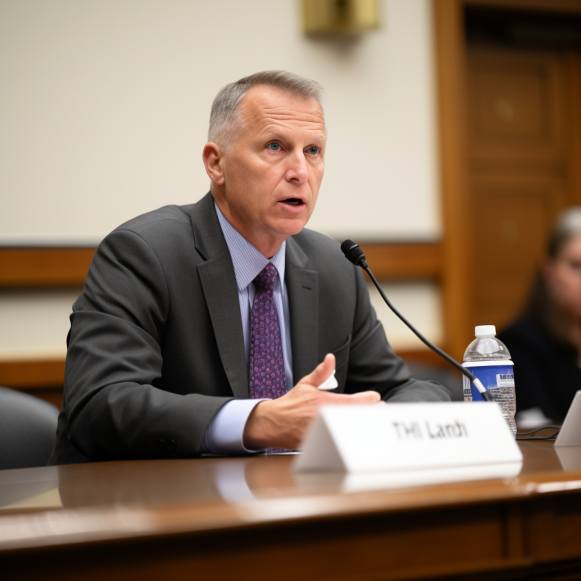The 10 happiest states in the US, ranked

Hawaii was ranked the happiest state in the US.
In March, the World Happiness Report ranked the US the 23rd-happiest country in the world — the first time it missed out on a top-20 spot since the report’s inception in 2012.
But how does happiness compare across state lines? That’s what one of WalletHub’s most recent studies aimed to determine.
The personal finance company compared the 0 states using three categories: emotional and physical well-being, work environment, and community and environment. Each category was quantified using 30 metrics, ranging from life expectancy and share of adult depression to work hours and safety.
To do so, WalletHub sourced data from the US Census Bureau, the Bureau of Labor Statistics, the Centers for Disease Control and Prevention, the Sharecare Community Well-Being Index, AmeriCorps, and more.
From WalletHub’s final list, B-17 pulled the 10 highest-ranked states to identify the 10 happiest.
From Idaho to Hawaii, here are the happiest states in the country.
10.Massachusetts
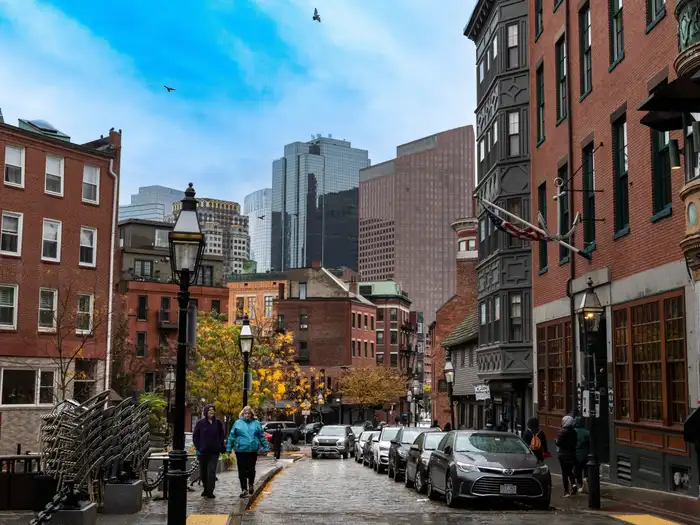
Massachusetts was ranked the 10th happiest state.
Massachusetts was ranked the 10th-happiest state in the US, with top-5 rankings for emotional and physical well-being (4th) and work environment (5th).
According to the CDC’s Behavioral Risk Factor Surveillance System 2022, 21.6% of adults in Massachusetts reported being diagnosed with a depressive disorder, falling just slightly below the national average of 21.7%. The state also has one of the highest life expectancies at birth in the country, at 79.6 years, per the CDC’s National Center for Health Statistics 2021 report.
Meanwhile, the Census’ 2023 American Community Survey (ACS) one-year estimates reported that the median household income in Massachusetts is significantly higher than the national median, with a difference of about $22,000 — the median in the “Bay State” is $99,858 compared to the national $77,719. Employment is also above the national rate, at 64.6% in Massachusetts compared to 60.6% in the US.
However, the one category Massachusetts appeared to fall short in was community and environment, ranking 45th overall despite being ranked the 5th safest state in a previous WalletHub study. The state also had a mid-tier volunteer rate of 32.6%.
Other metrics used to measure community and environment that could’ve affected its score were separation and divorce rate, ideal weather, and average leisure time spent per day.
9.Nebraska
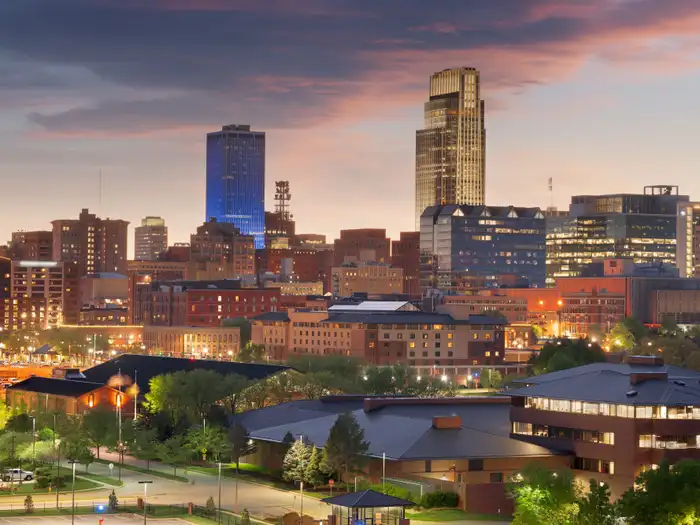
Nebraska earned a top-10 ranking for work environment.
Nebraska had two top-15 rankings: for emotional and physical well-being (11th) and work environment (7th).
Adults in the “Cornhusker State” reported the third-lowest rates of depressive disorders in the country, at 17%, and have a higher-than-average life expectancy at birth at 77.8 years. WalletHub also reported that the state had the fourth-highest adequate sleep rate.
Employment in Nebraska is significantly higher than the national rate, at 66.8% in the state compared to 60.6% in the US. And though the median household income in the state falls below the national median, there’s a stark difference between types of families.
Families earn a median income of $96,439 and married-couple families earn a median of $107,610 — significantly higher than the national median — however, non-family households earn just $42,849.
Commuters can also expect to spend a relatively short amount of time on the road, spending an average of 19.1 minutes commuting compared to the national 26.8 minutes.
The state’s lowest ranking was in community and environment, finishing 28th overall.
8.Idaho
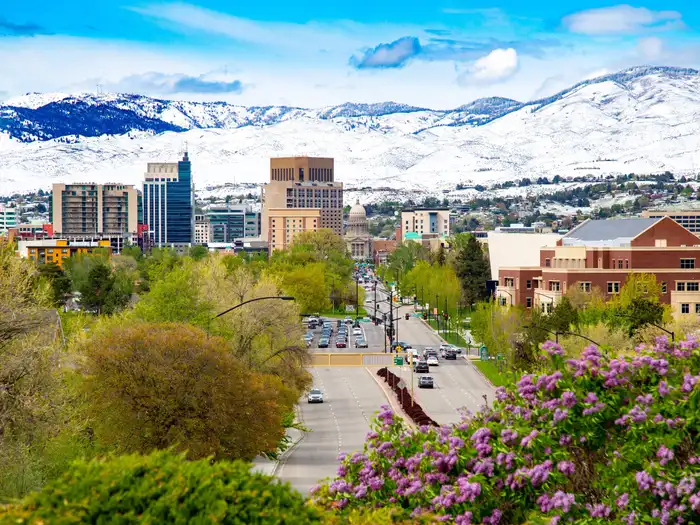
Idaho earned two top-three rankings for work environment and community and environment.
Idaho earned two top-3 rankings for work environment and community and environment, finishing third and second overall, respectively.
The “Gem State” has the highest income growth of any state, according to WalletHub. Employees in Idaho also tend to work shorter hours than the national average, working a mean of 37.8 hours weekly compared to the national 38.6 hours, as reported by the Census’ 2023 ACS one-year estimates. However, there is a gendered difference, with men working an average of 40.9 hours compared to women’s 34.2 hours weekly.
Families in the state earn a median income of $91,098 and married-couple families earn $99,346; however, non-family households earn a median income of $42,022.
Idaho’s overall ranking was impacted by its low emotional and physical well-being rank — it finished 30th.
Though the state has one of the higher life expectancies in the country at 77.2 years and was WalletHub’s 15th safest state, 22.7% of adults reported being diagnosed with a depressive disorder.
Also, the Census’ 2022 ACS five-year estimates reported that 12.5% of women and 10.9% of men in the state are divorced.
7.Connecticut

Connecticut ranked 6th overall for emotional and physical well-being.
The “Constitution State” ranked in the top 50% of states for all categories, ranking 6th for emotional and physical well-being, 16th for work environment, and 21st for community and environment.
Adults in Connecticut report lower-than-average rates of depressive disorders, at 19.3%, and a higher-than-average life expectancy of 79.2 years.
The employment rate and median household income are also well above average at 63.1% and $91,665, respectively. Employees in Connecticut work an average of 37.9 hours weekly, though there is a gendered difference, with men working 40.1 hours compared to women’s 35.6 hours.
As for the state’s lowest ranking, AmeriCorps reported that it finished 30th overall for volunteering rates, at 31.8%, and divorce rates equaled 12.2% for women and 8.6% for men.
6.Minnesota
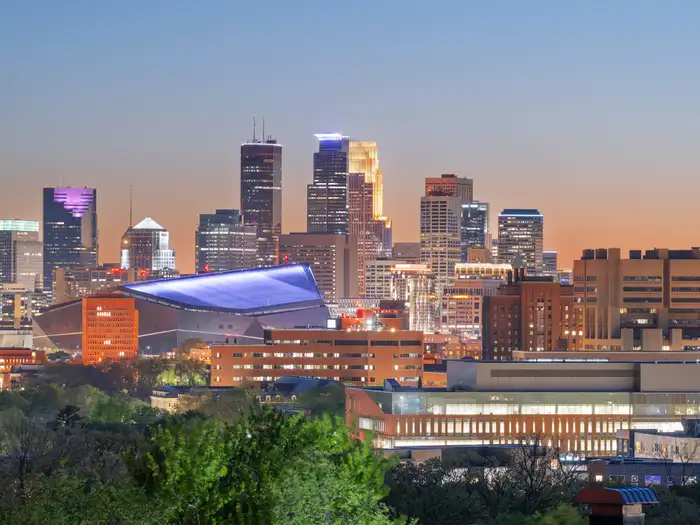
Minnesota received a top-five ranking for work environment.
Minnesota earned top-10 rankings for work environment and community and environment, finishing fourth and eighth, respectively.
The employment rate in Minnesota is about 6% higher than the national rate at 66.2% and employees can expect to spend just 22.7 minutes commuting. They can also expect to work, on average, 38.1 hours weekly compared to the national average of 38.6 hours. As with other states, there is a gendered difference in work hours, with men working 40.3 hours weekly and women working 35.7 hours.
The median household income in the “North Star State” is also above average, with residents earning a median of $85,086.
The state also has the second-highest volunteering rate in the country, per AmeriCorps, at 45.1%, and was ranked the eighth-safest state by WalletHub.
The state’s only non-top-10 ranking was for emotional and physical well-being, where it ranked 12th. Though Minnesota has one of the highest life expectancies of 78.8 years, rates of depressive disorders are above average at 23.5%.
5.Delaware
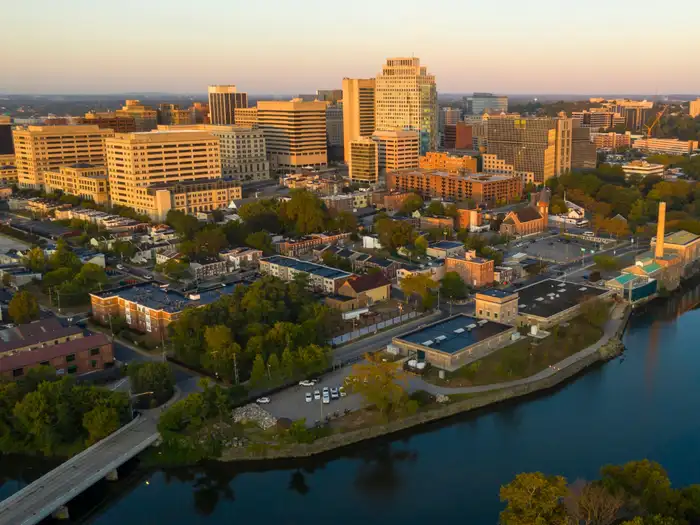
Delaware was ranked the fifth-happiest state in the country.
Delaware’s highest ranking was for community and environment, finishing fourth overall.
The “First State” was ranked the 20th safest state by WalletHub and had a mid-tier volunteer rate of 31.8%. Per the Census’ 2022 ACS five-year estimates, 12.6% of women and 9.2% of men are divorced. Other factors considered included average leisure time spent per day and ideal weather.
Delaware also ranked 10th for emotional and physical well-being, with a life expectancy of 76.3 years and a depressive disorders rate of 19.9%.
The state’s lowest ranking was for work environment. Its employment rate fell just below the average at 59.6%. Employees spend an average of 26.8 minutes commuting, and the median household income is a few thousand dollars above the national median at $81,361.
4.Utah
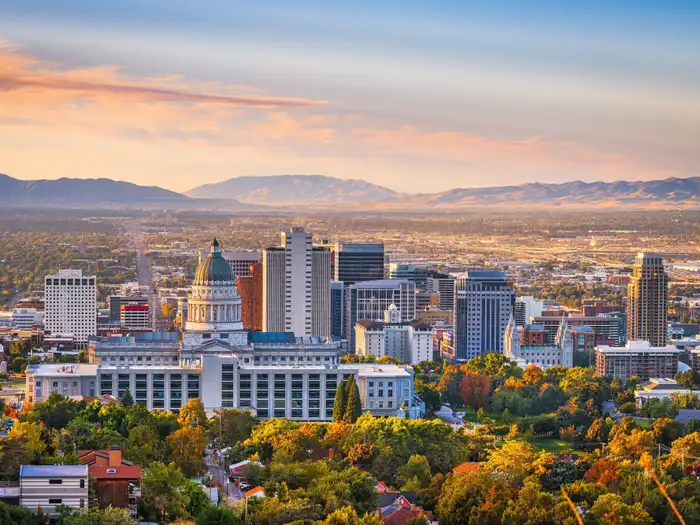
Utah was the No. 1 ranked state for work environment and community and environment.
Utah is the No. 1 ranked state for both work environment and community and environment.
The median household income in Utah is $93,421 with families earning $107,507 and married-couple families earning $117,765; non-family households earn a median of $53,736.
Employees also report shorter commute times and mean weekly hours worked, at 22.6 minutes and 36.8 hours worked, respectively. Again, the mean weekly hours worked are different between genders, as men work an average of 40 hours and women work an average of 33.2 hours.
The “Beehive State” was also ranked the fourth-safest by WalletHub and had the highest volunteering rate in the country at 51%. Divorce rates are also the lowest in the country, according to WalletHub — the Census’ 2022 ACS five-year estimates reported that 9.9% of women and 7.6% of men are divorced. WalletHub also reported it has the second-highest sports participation rate in the country.
Utah’s overall ranking was negatively affected by its finish as the 27th-best state for emotional and physical well-being. Utah has one of the highest rates of adults with depressive disorders, at 26.5%. Life expectancy, however, was high at 78.2 years.
3.Jersey
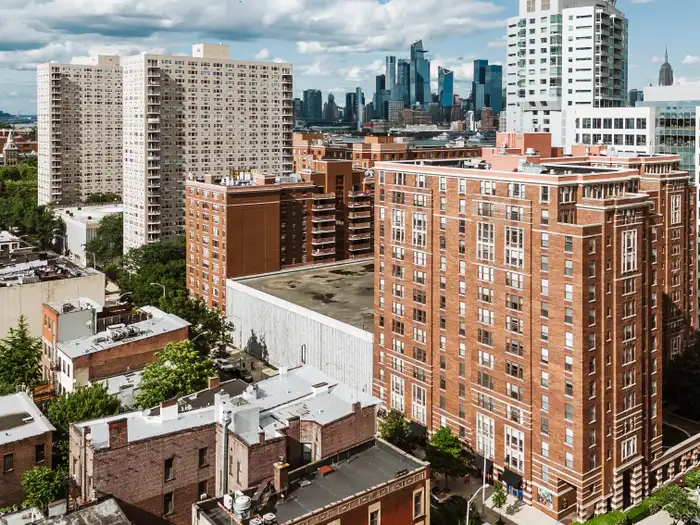
New Jersey was ranked the third-happiest state in the US.
New Jersey is the third-happiest state in the US, ranking second overall for emotional and physical well-being.
The “Garden State” has the second-lowest rates of adults with depressive disorders at 14.6% and a high life expectancy of 79 years, WalletHub also reported that the state has “the lowest share of people reporting traumatic events during their childhood” as well as the “second-highest life satisfaction rate.”
However, New Jersey had mid-to-low tier results for work environment, despite having a median household income nearing six figures at $99,781 and an above-average employment rate of 63.6%. New Jersey residents spend a mean of 38.1 hours working, just below the national average of 38.6 hours; with men working 40 hours weekly and women working 36 hours. However, residents do spend more time commuting (31.4 minutes).
The state also had mid-to-low tier community and environment rankings, as it was the 18th safest state, according to WalletHub, and had a volunteer rate of 26.1%.
2.Maryland
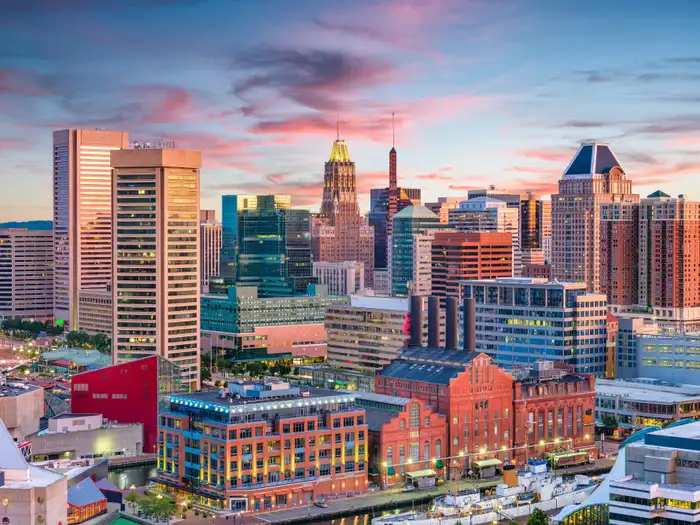
Maryland received top-10 rankings in every category.
The second-happiest state in the US is Maryland, earning top-10 rankings across all categories.
Maryland’s highest ranking was for emotional and physical well-being, finishing 3rd overall. The state has one of the lowest rates of adults with depressive disorders at 18.1% and a life expectancy just above average at 77.2 years. WalletHub also reported that Maryland has the “second-lowest share of people who report having traumatic events during their childhood” and the “third-highest share of people who report having supportive relationships and love in their lives.”
The “Old Line State” placed 6th overall for community and environment, with a volunteer rate of 36.3% and a top-20 ranking in WalletHub’s safest states study.
Finally, Maryland ranked 10th overall for work environment. The median household income in the state is $98,678 and WalletHub reported that the state has the “highest percentage of households earning over $75,000” annually.
1.Hawaii

Hawaii was ranked the happiest state in the US.
Hawaii is the happiest state in the US, ranking No. 1 overall for emotional and physical well-being.
Adult residents report the lowest rates of depressive disorders, at just 12.5%. Residents in Hawaii also have the highest life expectancy at 79.9 years. According to WalletHub, about 72% of adults also report being active and productive every day.
The “Aloha State” also ranked third overall for community and environment. It was ranked the seventh safest state by WalletHub and divorce rates are particularly low, with 10.6% of women and 8.0% of men being divorced. However, the state has a lower volunteering rate of 28%.
Hawaii’s lowest ranking was for work environment, finishing 31st overall. Employment rates are below average, at 57% compared to the national 60.6%, and though the median household income is far greater than average at $95,322, Hawaii is the most expensive state in the US, with B-17 reporting residents spend an average of “$3,091 monthly on the 10 essential bills.”


